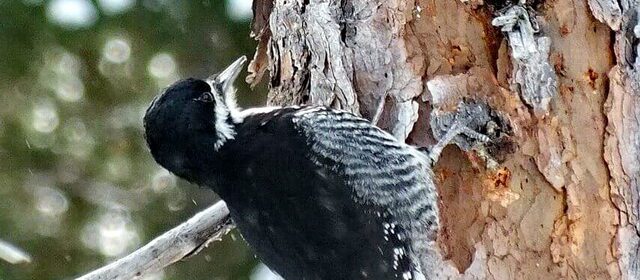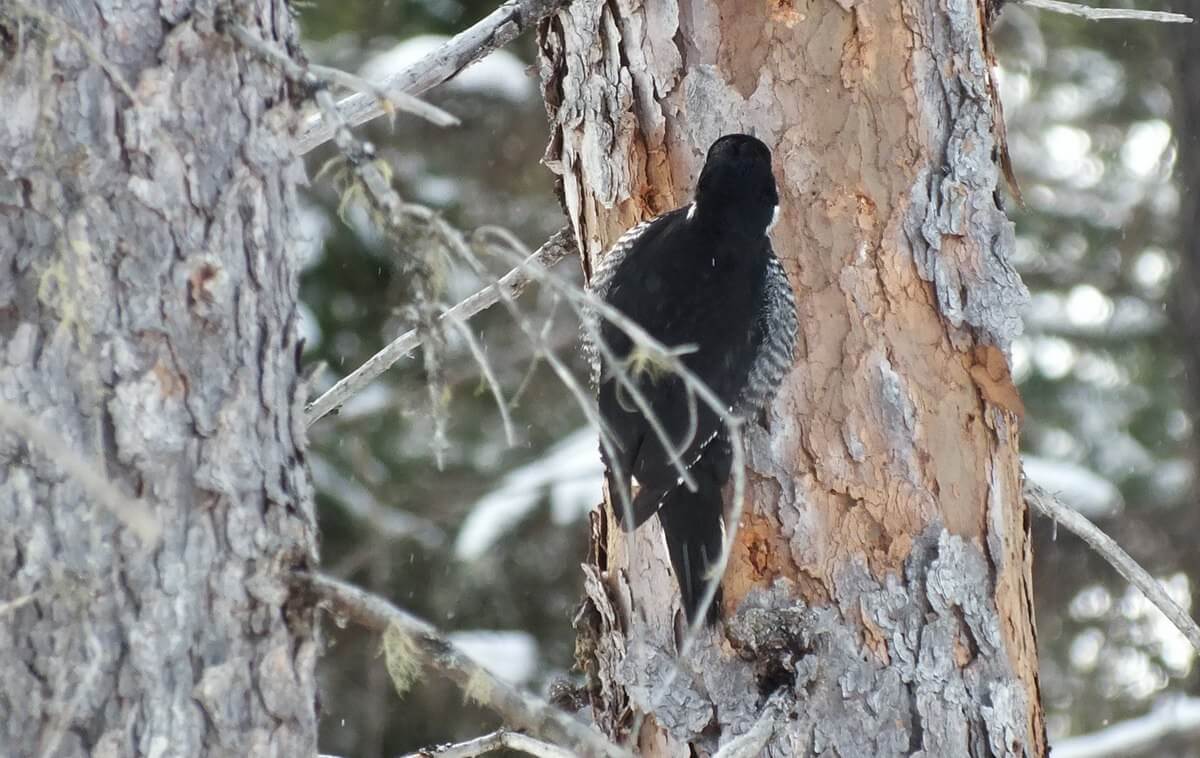Black-backed Woodpecker In Algonquin Provincial Park

On one of our winter excursions, Bob and I drove to Algonquin Provincial Park , in Ontario, where we got to see a Black-backed Woodpecker when hiking along the Spruce Bog Boardwalk Trail.
Late Saturday afternoon, beneath a heavy, overcast sky, Bob and I set out on the short 1.5 kilometer loop that guides visitors through two typical northern spruce bogs.
A brisk north wind buffeted us as we crossed one of the many boardwalk sections of the trail. There was no protection from the elements on that exposed expanse of the bog,
whereas, the thick stands of spruce trees provided a great windbreak once we left the open area of the bog behind.
A short distance from the parking lot, the park’s staff have erected a bird feeder which is highly popular with various species of birds. When Bob and I first approached the feeding station, a female Hairy Woodpecker was already engaged in pecking bits of suet from within the wire cage.
Seeing no other birds of note at that time, we continued along the trail in search of the Black-backed Woodpecker that had been reported at that location in recent days. The trail conditions were excellent…hard-packed from repeated use.
It was Bob who first spotted the bird on the side of a tree trunk. Black-backed Woodpeckers prefer coniferous woodlands and burned areas with standing dead trees. I suppose that is why this particular bird is wintering on the fringes of a spruce bog.
Black-backed Woodpeckers are often detected by their foraging taps, bark prying, and drumming.
In this video that Bob filmed, you get a great chance to both see and also hear the woodpecker drumming away on the tree.
Black-backed Woodpeckers are comparable in size to the Hairy Woodpecker, between 9-10 inches in length.
This female exhibits the heavily black and white barred flanks of the species, as well as the broad white stripe below the eye. A male Black-Backed Woodpecker would have a yellow crown.
Its unmistakeable solid black back distinguishes this woodpecker from the Northern Three-toed Woodpecker. In some light, the black back can take on a bluish tinge.
This angle reveals the white belly of the woodpecker.
Three instead of four toes distinguishes the Black-backed Woodpecker from other woodpeckers except the aptly named Northern Three-toed Woodpecker.
Black-backed Woodpeckers are known for following outbreaks of wood-boring beetles. I wonder if that is what this female is delving for deep in the wood of this tree trunk. This picture shows clearly the white throat, chest and belly, and also how the woodpecker braces itself against the tree using its two tail feathers.
After spending about 45 minutes taking pictures of the woodpecker and its whereabouts, Bob and I continued along the trail wondering what other surprises would be in store for us.
Lots of evidence was visible where other animals had been moving about the forest and the bog, including rabbit and fox tracks. We had no luck, however, spotting the pine marten that lives there.
Black-backed Woodpeckers are alternately referred to as Arctic Three-toed Woodpeckers. They are particularly scarce in conifer forests so we were very lucky to see this unique bird.
Frame To Frame – Bob and Jean



















We saw the pine marten at Spruce Bog around 8:30am and then one at Opeongo Rd around 4:30pm. I have posted that one now too and some of the Great Gray along Hwy 60 near Opeongo Rd…think around mile marker 48 or so.
thanks so much for the input, Karen. If we get a chance to be in Algonquin over the next while, Bob and I will try again to see the pine marten…and the male black-backed woodpecker. It is amazing how luck plays such an important part in spotting any wild animal. A short time before we arrived at the Visitors’ Center, people had observed wolves at the moose carcass in the swamp visible from their deck. Despite trying a couple of other times, we failed to see any wolves.
Hello Jean and Bob! It was nice to meet you in person the other day – looking forward to your post about the Wild Turkeys and Barred Owl. I did venture out to Algonquin Park on Saturday – the weather was perfect. Had very good sightings of Pine Grosbeaks, Boreal Chickadees, Gray Jays, Spruce Grouse and Great Gray Owl. Did not see the Black-backed Woodpecker, but spotted and photographed Pine Marten and a Moose – that really made my day. Take care and see you around. Anna
Whoa! That’s amazing! I have never seen a Spruce Grouse, and I lived in the area for my whole childhood. For that matter, I have never seen a Pine Marten either. I am so glad that you were inspired by our blog to visit Algonquin Park. It is a wonderful place. We were so thrilled to meet you the other day, too. Thanks for identifying yourself to us. Bob and I will be putting up a blog posting about the Barred Owl and Eastern Wild Turkeys, but not before we put up a blog about our most recent sighting. Yesterday, our son took us to Claireville Conservation Area where we got good pictures and video footage of a coyote. It was very exciting for us.
I was in the park on Thursday and we did not see a black backed at Spruce Bog but did capture images of a male near the gate parking area on Opeongo Rd. We did see 2 martens with good captures, one at the same feeder at Spruce Bog and one at Opeongo Rd…along with good sightings of the boreal chickadees at both the same areas as well. What is being called the leusictic chickadee was also seen but it may indeed be a partial albinistic chickadee as identified by Michael Runtz who just happened to be there at the same time. A great day indeed!
You had amazing luck, Karen, to see so much wildlife on one trip to Algonquin. What time of the day was it when you observed the pine martens? I had a look at your website, and you are a gifted photographer, in my opinion. What a selection of beautiful images!
The black-backed woodpecker is a burnt-forest specialist. Feeding on wood-boring beetles, which attack forests after they have experienced a fire. Also, the male can be very easily identified by its yellow cap on its head. The one you have photographed is obviously a female. But that is what is so important about woodpeckers, is that they are empirical indicators about a forest’s health. Australia is a continent, that has never had any woodpeckers, but North America, South America, Africa, and Asia have them. In North America, it is feared that both the Ivory-billed and Imperial woodpeckers are extinct, and the red-cockaded is decreasing.
Those are interesting details. Thanks for your input.